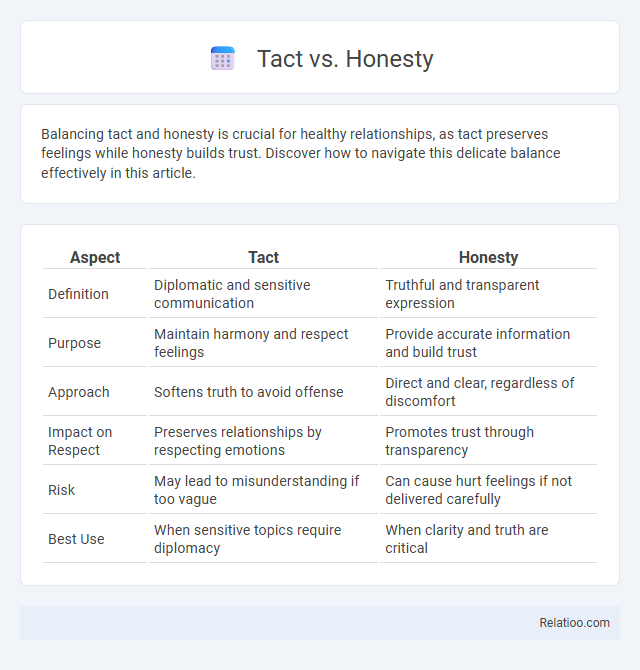Balancing tact and honesty is crucial for healthy relationships, as tact preserves feelings while honesty builds trust. Discover how to navigate this delicate balance effectively in this article.
Table of Comparison
| Aspect | Tact | Honesty |
|---|---|---|
| Definition | Diplomatic and sensitive communication | Truthful and transparent expression |
| Purpose | Maintain harmony and respect feelings | Provide accurate information and build trust |
| Approach | Softens truth to avoid offense | Direct and clear, regardless of discomfort |
| Impact on Respect | Preserves relationships by respecting emotions | Promotes trust through transparency |
| Risk | May lead to misunderstanding if too vague | Can cause hurt feelings if not delivered carefully |
| Best Use | When sensitive topics require diplomacy | When clarity and truth are critical |
Understanding Tact and Honesty
Understanding tact involves recognizing the importance of conveying messages with sensitivity and respect to maintain positive relationships, while honesty emphasizes truthfulness and transparency regardless of potential discomfort. Balancing tact and honesty requires delivering truthful information in a considerate manner that minimizes hurt or conflict. Effective communication hinges on the ability to be honest without compromising kindness, fostering trust and mutual respect.
The Importance of Balance
Balancing tact and honesty is essential for effective communication and maintaining strong relationships. Tact enables conveying sensitive information respectfully, while honesty fosters trust and transparency. Mastering the interplay between these qualities helps avoid misunderstandings and promotes mutual respect.
When to Prioritize Tact
When navigating sensitive conversations, prioritize tact to maintain your relationships and avoid unnecessary conflict, especially in professional or emotionally charged situations. Tact involves delivering honest messages with consideration and diplomacy, ensuring your point is clear without offending the listener. Your choice to emphasize tact over blunt honesty can foster trust and cooperation, ultimately leading to more constructive and positive outcomes.
When Honesty Takes Precedence
Honesty takes precedence in situations requiring clear, truthful communication to maintain trust and integrity, especially when decisions impact safety or ethical standards. While tact softens delivery, prioritizing honesty ensures transparency and accountability, critical in leadership and conflict resolution. Balancing honest feedback with respectful phrasing helps preserve relationships without compromising essential truths.
The Consequences of Brutal Honesty
Brutal honesty can damage relationships by causing emotional pain and eroding trust, making tact essential for delivering truthful feedback with sensitivity. You risk alienating colleagues or loved ones when honesty lacks empathy, potentially leading to conflicts or social isolation. Balancing tact with honesty preserves communication effectiveness and maintains respect while conveying necessary truths.
The Risks of Excessive Tact
Excessive tact can obscure your true intentions, leading to miscommunication and mistrust in professional and personal relationships. When tact is overused, important issues may be avoided or sugarcoated, causing unresolved problems and frustration. Balancing honesty with tact ensures clarity while maintaining respect, preventing the risks associated with excessive diplomacy.
Strategies for Blending Tact with Honesty
Balancing tact with honesty requires clear communication that respects others' feelings while conveying truth. Employ empathetic language and choose words that soften criticism without diluting the message, ensuring your honesty remains constructive. Your approach enhances relationships by fostering trust and understanding through considerate, yet truthful dialogue.
Real-Life Scenarios: Tact vs Honesty
In real-life scenarios, tact involves delivering your message with sensitivity to avoid unnecessary offense, while honesty prioritizes truthfulness even if it risks discomfort. Balancing tact and honesty allows you to communicate transparently without damaging relationships, especially in sensitive conversations at work or with family. Understanding when to soften the truth and when to be straightforward enhances your social effectiveness and trustworthiness.
Developing Communication Skills
Developing communication skills requires balancing tact, honesty, and empathy to foster clear and respectful interactions. Tact involves delivering messages thoughtfully to avoid offense, while honesty ensures transparency and trustworthiness in conversations. Mastering this balance enhances emotional intelligence, conflict resolution, and relationship-building abilities in professional and personal settings.
Achieving Authentic, Respectful Dialogue
Balancing tact and honesty is essential for achieving authentic, respectful dialogue that fosters trust and openness. Employing tact ensures that honesty is communicated with sensitivity, preventing misunderstandings and emotional harm while maintaining transparency. Prioritizing both allows conversations to be genuine and constructive, promoting mutual respect and meaningful connections.

Infographic: Tact vs Honesty
 relatioo.com
relatioo.com